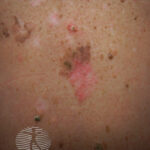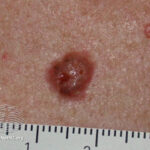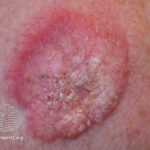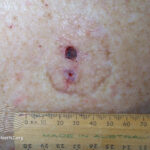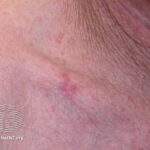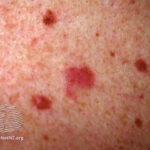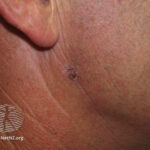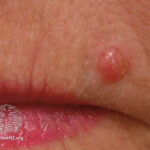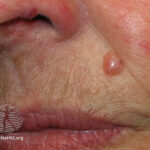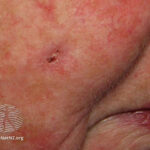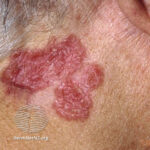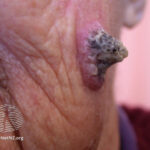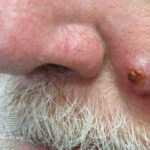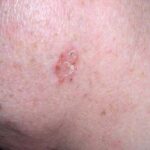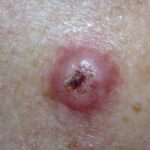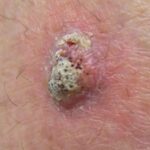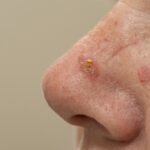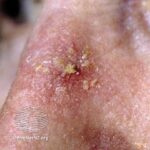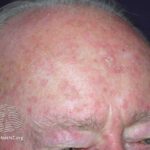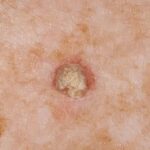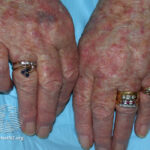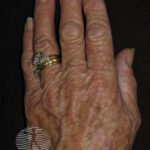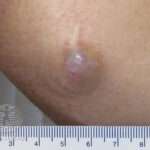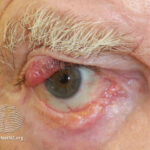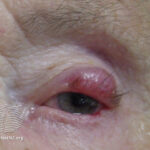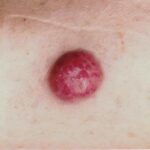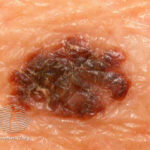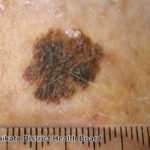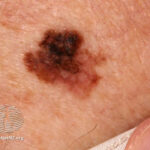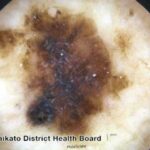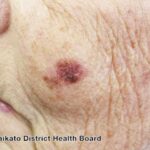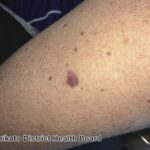Skin Cancer Images

What Does Skin Cancer Look Like?
Skin cancers will look different from one person to another because of variations in skin tone, tumor size and location, and skin cancer type. Yet there are some general signs of skin cancer to look for on your skin. Often, skin cancer presents itself as a change on your skin—a spot, mole, mark, or lesion that has newly appeared on your skin or one that has been on your skin but recently changed in appearance. The suspicious spot, mole, mark, or lesion may look different from other spots, moles, marks, or lesions on your skin, and it may bleed or itch.
Consult a dermatologist if you notice a concerning spot on your skin—don’t waste time comparing your mole or mark with various pictures of skin cancer. Skin cancer on your body may look different from skin cancer found in online images. The earlier skin cancer is diagnosed, the easier it is to treat.
Many of the images below show skin cancer in lighter-skinned people. For images and information on skin cancer in skin of color, click here.
BASAL CELL CARCINOMA (BCC)
Basal cell carcinoma (BCC) is by far the most common type of skin cancer. BCC can appear as a fleshy-colored, slightly transparent, and/or shiny bump or lesion on the outside layer of your skin that does not disappear over time. BCCs tend to grow slowly, sometimes breaking down and ulcerating (meaning the skin is not intact). BCCs usually appear on areas of the skin exposed to high levels of UV radiation from the sun such as the head, neck, ears, and the back of the arms and hands. Below are pictures of BCC on the face and trunk. These images show common areas where BCC develops, but BCC can develop anywhere. Indeed, BCCs can develop in locations not exposed to the sun, such as the genitals, especially in darker-skinned people.
What are the signs of Basal Cell Carcinoma?
BCC may appear as:
- An open sore that bleeds, oozes, or crusts and remains open for at least two weeks
- A red, raised patch or irritated area that may crust or itch but generally doesn’t hurt
- A shiny pink, red, pearly white, or translucent bump
- A pink growth with a raised border and crusted central indentation
- A scar-like, white, yellow, or waxy area, often with a poorly defined edge
- A darker-colored (pigmented), pearly, translucent skin growth (more common in skin of color than in light skin)
- An ulcerated lesion, which means a portion of the skin that covers the growth is not intact
SQUAMOUS CELL SKIN CANCER
Squamous cell skin cancer (SCSC, also called squamous cell carcinoma and cutaneous squamous cell carcinoma) is the second most commo type of skin cancer after basal cell carcinoma. Many SCSCs appear as wounds that never heal. They grow relatively slowly and may look red, scaly, crater-like, ulcerated, or bumpy. Some are crusty, itchy, and bleed. Most SCSCs appear on the skin in places exposed to ultraviolet (UV) radiation such as the ears, neck, and head. Although less frequently, the lips can also develop SCSC.
SCSC may develop in damaged and inflamed areas of the skin, such as on or around scars, chronic ulcers, and previous sites of burns. They vary in size, and they can cause numbness, pain, and muscle weakness if invading a nearby nerve.
What are the signs of squamous cell skin cancer?
SCSC may appear as:
- A rough-feeling bump or growth, which might crust over and bleed
- A wart-like growth
- A wound or sore that does not seem to heal, or a sore that heals and then comes back
- An area of skin that is flat, scaly, and red
ACTINIC KERATOSES: SQUAMOUS CELL PRECANCER
Actinic keratoses (AKs) are precancerous spots with cells that could become SCSC. They are also called solar keratoses and are caused by sun damage from UV radiation. An individual AK is a small, dry, scaly, or crusty skin patch. AKs are very common and have a rough texture that you can feel. The color varies from red to dark tan to white to flesh-colored, or they are a combination of colors. Clinicians recommend removal because some will become cancer, but you cannot predict which ones will or will not transform.
MERKEL CELL CARCINOMA
Merkel cell carcinoma (MCC) is a rare, aggressive skin cancer that is much more likely than BCC or SCSC to spread to other parts of the body. It can be challenging to treat if it has already spread. MCC often appears as a flesh-colored or bluish-red dome-like nodule growing on your skin. It may look like a rapidly growing stye or cyst and usually appears in areas of skin exposed to the sun’s UV radiation, such as on your face, head, neck, or arms. MCC is also sometimes called a neuroendocrine carcinoma of the skin because it arises from the Merkel cells (touch receptors), which are part of the neuroendocrine system.
What are the signs of Merkel cell carcinoma?
MCC may appear as:
- A dome-like nodule on your skin
- A painless, firm bump that can be red-purple or skin-colored
- A shiny or pearly lump on an area of skin that gets a lot of sun exposure
- Lumps that grow large enough to be seen or felt as lumps under the skin, usually in the neck or under the arm
MELANOMA
Images of melanoma are included below, but this website is focused on nonmelanoma skin cancers. For comprehensive information on melanoma, including how to spot one, please visit our AIM at Melanoma website.
Melanoma is the third most common skin cancer, after BCC and SCSC. But melanoma is much less common than these other two skin cancers. While millions of cases of basal cell carcinoma and squamous cell skin cancer are diagnosed each year in the U.S., just under 200,000 cases of melanoma have been diagnosed in each of the last few years. Melanoma can appear differently on different people, but it may appear as a spot that looks unlike others on your skin: It might be a lighter colored or darker colored mole or lesion than the others around it, or it might be a larger or smaller mole or lesion than others around it. And as with other skin cancers, one sign of melanoma is any newly appearing or newly changing spot, lesion, or mole on your skin.
What are the signs of melanoma?
Melanoma may appear as:
- A mole or lesion that is asymmetrical or has uneven borders
- A mole or lesion that is multi-colored or that has lost color itself or lost color in the area around it
- A larger or otherwise different spot, mole, or lesion than others on your skin
- Any spot, mole or lesion that has recently appeared or that has recently changed
- Dermoscopy of a superficial spreading malignant melanoma – irregular edge and pigmentation and a blue-grey veil
- An irregularly marginated and pigmented lesion on the cheek – a superficial spreading malignant melanoma
- An ugly duckling pigmented lesion on the arm – a superficial spreading malignant melanoma


